

Introduction
After taking Business Japanese at the Japan Foundation, Los Angeles location, I had the honor of being selected for the Japan Foundation Study Tour in Osaka, Japan for 2 weeks in November 2012. I was the only student selected from the United States and was one of 35 students of various ages and backgrounds selected from Japan Foundation offices around the world. Staying at the Japan Foundation was a truly immersive experience in Japanese culture and the language.
A personal note--I've spent over 10 years of my life studying Japanese from middle school through the end of college. Upon graduating from University, I no longer had the opportunity to use Japanese in my daily life and my skills fell out of use, so I decided to enroll in the Japan Foundation classes in 2012 to refresh what my skills. I found that indeed, I had a lot to learn in the class, and even more discoveries would await me in Japan.
Tuesday, November 6 - Leaving Home
Took United Airlines from Los Angeles to San Francisco and landed with 1 hour 10 minutes of layover time till the next flight to Kansai International airport.
Wednesday, November 7 - Arrival in Japan
 Arrived at Kansai International Airport in the late afternoon. After clearing immigration and customs, took the Airport Express train to Rinku Town station (first stop) and the shuttle bus to the Japanese-Language Institute. I was given an ID card that served as a meal ticket, debit card, and room key for my dorm room on the 17th floor.
Arrived at Kansai International Airport in the late afternoon. After clearing immigration and customs, took the Airport Express train to Rinku Town station (first stop) and the shuttle bus to the Japanese-Language Institute. I was given an ID card that served as a meal ticket, debit card, and room key for my dorm room on the 17th floor.
The institute itself is located in Tajiri-cho, a quiet town on the south side of the greater Osaka area. Near the Rinku Town station is Rinku Premium Outlets (which feels very similar to the Camarillo Premium Outlets or Carlsbad, because they are in fact owned by the same group), with a number of local Japanese and international brands.
Thursday, November 8 - Orientation
In the morning, I anxiously took my place in the main hall of the institute where desks had been arranged and assigned by ID number. Once all 35 students were assembled, everyone stood up one-by-one and did a brief self-introduction. I learned that I was the only one from the United States, and one of two from an English-speaking country. Other students came from such exotic locales as Kazakhstan, Indonesia, Ukraine, France, Russia, Thailand, Uzbekistan, Hungary, Mongolia, Egypt and Laos. Later on I came to find that the majority of the other students were extremely proficient in English as well as Japanese, though there were a few that did not speak any English at all. I was greatly impressed by everyone's Japanese-language aptitude, and a bit embarrassed at my low speaking level, since being from Los Angeles, I certainly had greater access to Japanese-language learning materials and classes than students from many of these other countries. Afterwards, we each received a pre-paid train card, a generous stipend of spending cash, and phone cards that would allow us to call home internationally if we needed to. Our main teacher and chaperone was introduced to us as Yoshimori-sensei, a young woman around my age.
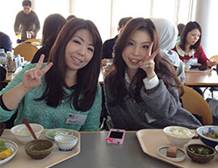
After orientation, we were given a tour of the facility, which included a large library with wide range of educational resources in nearly every language spoken by the visiting students; a study room with internet access (though the rooms had internet access as well); a karaoke room, a gym, and laundry facilities on several floors.
At lunch, we were asked to return to the cafeteria and we would have an intercultural exchange activity with female students visiting from Kobe Shoin Women's University. Over lunch and throuh "Ice breaker" activities in the afternoon, we made new friends with the girls, who were as curious about us as we were about them.
Friday, November 9 - Lecture
In the morning, we split up into groups for some simple Japanese language instruction, with some lecture about the geography of Japan, Japanese culture in general, etc. I was placed in the most advanced group, which included a few students who were nearly fluent as well as some like myself who had a bit more of a challenge speaking for a long period of time.
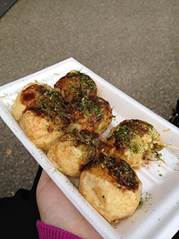 After lecture time, we went back to the main hall for a lecture on Kansai-ben (関西弁), the local dialect. Unlike standard Tokyo Japanese, we found that Kansai-ben has a more casual, friendly feel that reflects the personalities of those in the Kansai area. Also surprising to me in particular was that bargaining is not only an accepted cultural practice when shopping in Osaka, but is sometimes even encouraged if one wants to get the best deal!
After lecture time, we went back to the main hall for a lecture on Kansai-ben (関西弁), the local dialect. Unlike standard Tokyo Japanese, we found that Kansai-ben has a more casual, friendly feel that reflects the personalities of those in the Kansai area. Also surprising to me in particular was that bargaining is not only an accepted cultural practice when shopping in Osaka, but is sometimes even encouraged if one wants to get the best deal!
After lunch, we were split up into groups to prepare for the "Osaka Orienteering" activity that consisted of a 'treasure hunt' in the city of Osaka. Each group pulled an itinerary at random that would direct which landmarks they would need to visit the following day.
In addition to the assigned locations, my group decided we should make the most of our day out in Osaka and try to visit as many sightseeing spots as possible in addition to Shitennouji (四天王寺) and the Osaka Maritime Museum (なにわの海の時空間) , which we were required to visit and report on during Monday's lecture time.
Saturday, November 10 - Osaka Orienteering
Our group decided to meet bright and early and take the shuttle bus to the Rinku Town train station and use the Nankai Train line to get around Osaka. Our first stop was at Shitennouji, a Buddhist temple complex built by Prince Shotoku in 593. Not to waste any time, we then headed to Osaka Castle (not on our assigned list of places) to take photos, tour the museum, and eat some takoyaki (たこ焼き) after running into some other students from our class.
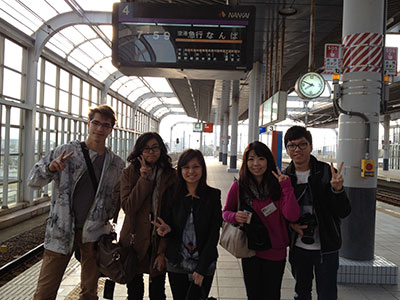
In the afternoon, we took the train all the way to the western port side of town to the Osaka Martime Museum, which contained a number of exhibits about shipbuilding and maritime voyages throughout the ages. After this, we were hungry again, so we decided to walk to a shopping center next door and grab a bite to eat, though we ended up just getting more snacks. It so happened that there was an anime cosplay event taking place at this same complex, so since part of our assignment included interviewing and taking pictures with some locals, we made some friends with a few brightly-attired young adults and took photos with them.
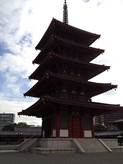
We had decided early on in the day that we wanted to finish the day eating dinner at Dōtonbori (道頓堀), but since the Maritime Museum was rather far, we decided to stop off at Umeda station in the heart of the city and visit the Umeda Sky Building, which was an assigned location for two of the other groups. Umeda station felt like one of the busiest in the world, and after managing to not lose anyone in our group, we made it to the foot of the immense Umeda Sky Building, where we took the elevator to the rooftop observatory and took photos of the breathtaking city view amidst the darkening sky.
As planned, we took the train back to Namba station for Dotonbori, a famous dining and entertainment street famous for its brightly lit signs and boisterous atmosphere, and tried some delicious do-it-yourself okonomiyaki (お好み焼き) before heading back to catch the last shuttle back to the Institute.

Sunday, November 11 - Free Day
Our group decided to gather in the morning to compare notes and come up with a presentation for the following day. We ended up with hundreds of photos and lots of things to show and tell. I had originally planned to use this day to go to Wakayama prefecture to visit my grandparents' ancestral village, but the time we needed to prepare plus the threatening weather made me decide to postpone this trip to the following week. In the afternoon, I took a solitary trip to Namba station and did some shopping.
Monday, November 12 - Lecture/Japanese Cultural Experience
In the morning, we had presentations on our Saturday excursions and an information session on the field trip to Kyoto and Tokyo that would begin the following day.
After lunch, we headed to separate rooms for cultural learning activities. My activity for the afternoon was shodo (書道), Japanese calligraphy. After some practice sessions with a brush and ink, we were given display boards to write a single kanji on to take home.
At the end of the day, we were taken back to the main hall and given the chance to select up to ¥4,000 in Japanese-language textbooks as part of the program.
Tuesday, November 13 - Kyoto
Instead of taking the train, a charter bus arrived early in the morning to drive us to Kyoto. Our Kyoto Day 1 itinerary included -
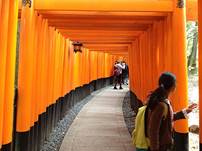 Fushimi Inari Shrine (伏見稲荷大社) - The main shrine of Inari, the Shinto god of rice, agriculture, and business that is said to manifest the form of a fox. The shrine is famous for long, complex pathways into the mountains formed by thousands of red torii gates, each donated by worshipping persons and businesses (and apparently replaced at 20-year intervals).
Fushimi Inari Shrine (伏見稲荷大社) - The main shrine of Inari, the Shinto god of rice, agriculture, and business that is said to manifest the form of a fox. The shrine is famous for long, complex pathways into the mountains formed by thousands of red torii gates, each donated by worshipping persons and businesses (and apparently replaced at 20-year intervals).

In the evening, we were taken to an inn-style hotel called Touzankaku (東山閣), which featured a full formal dinner and a Japanese-style communal bath. Being American, I was hesitant to disrobe in front of my classmates, so I decided to take my bath a bit later in the evening. The feeling of the hot soaking tub on tired bones and clean skin is incredible.
The rooms were Japanese-style, with a single bed and the rest of the bedding intended to be laid out on the floor (5 to a room).

Wednesday, November 14 - Kyoto/Tokyo
 After a full hotel breakfast, we were taken by bus to the nearby Kiyomizu Temple (清水寺), a grand Buddhist temple complex with an attached Shinto Shrine, which was founded in 798 and is on the list of UNESCO World Heritage Sites.
After a full hotel breakfast, we were taken by bus to the nearby Kiyomizu Temple (清水寺), a grand Buddhist temple complex with an attached Shinto Shrine, which was founded in 798 and is on the list of UNESCO World Heritage Sites.
Following Kiyomizu Temple, it was time to leave Kyoto and head to Tokyo via shinkansen (新幹線), the bullet train, a nearly 3-hour journey. Lunch was a delicious bento on the train.
In the late afternoon, the train pulled into Tokyo station and we boarded another bus to Akihabara "Electric Town", the hub of electronics, anime stores, and general geek interests in Tokyo for sightseeing and shopping. Alternatively, those who didn't want to go to Akihabara had the option of going to the Ueno Zoo instead.
In Akihabara, I got separated from the others and wandered around by myself for awhile to hunt for some souvenirs. I ended up at Don Quixote, a giant discount-type store that on its top houses the home stage of the famous pop group AKB48. After we re-grouped, we got on the bus and headed for Tokyo Tower for more sightseeing.

We spent the evening at the dormitory of the Japanese-Language Institute, Urawa in Saitama, about an hour away from Tokyo tower by bus.
Thursday, November 15 - Tokyo
After having had a late dinner the night before, I skimped on breakfast at the Urawa institute and met the assembled group in the morning while we waited for charter bus to pick us up for more sightseeing around Tokyo:
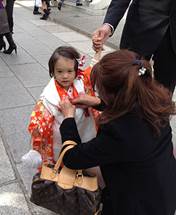 Edo-Tokyo Museum (江戸東京博物館) - A grand museum with artifacts and models illustrating the history of how Edo, a small seaside town became the megalopolis of Tokyo that it is today, this museum was too large for us to walk through in an hour and a half, especially with the languid pace of our English-speaking tour guide. However, we were able to at least see most of the main hall before we had to leave.
Edo-Tokyo Museum (江戸東京博物館) - A grand museum with artifacts and models illustrating the history of how Edo, a small seaside town became the megalopolis of Tokyo that it is today, this museum was too large for us to walk through in an hour and a half, especially with the languid pace of our English-speaking tour guide. However, we were able to at least see most of the main hall before we had to leave.From Mirai-kan, we were taken by bus to Haneda Airport to go back to Osaka via ANA domestic. We had booked a group ticket, and it seems like security at the airport is not as strict for a domestic flight as it is in the US. I was also stopped and asked to sign up for a credit card and bought some regionally-flavored candy.
Friday, November 16 - Lecture/Japanese Cultural Experience
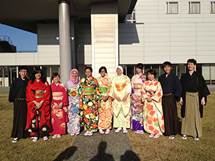 Back in Osaka, we had lectures discussing what we had seen on our trip, what was most interesting, what we liked the most, etc. Then, we had an information session about a Home Visit we would have the following weekend with a local family.
Back in Osaka, we had lectures discussing what we had seen on our trip, what was most interesting, what we liked the most, etc. Then, we had an information session about a Home Visit we would have the following weekend with a local family.
In the afternoon, my assigned cultural activity was kitsuke (着付け), or how to wear a kimono. Despite being Japanese-American, I had only worn a kimono once before in my adult life (on a previous trip to Japan when I was in college), so it was very exciting to not only be dressed in a kimono, but also to watch how others were being dressed. I don't think I could reproduce the experience with good results again, but I'd like to try.
After we were all dressed, we went outside to take photos as a group, which ended up appearing very formal.
Saturday, November 17 - Home Visit
 On Saturday, we had the pleasure of spending the day with a local family in groups of two or three. I was paired with a young man from France and another from Laos to spend the day with the Nagayama family, who lived not far from the Institute in Tajiri-cho. After picking us up from the Institute, the Nagayamas took us to a local museum in nearby Kishiwada (岸和田) that showcased the temporary portable shrines known as mikoshi (神輿) used in the yearly Kishiwada Danjiri Festival (岸和田だんじり祭). After lunch at a local "French" cafe, we went to the Aeon Mall to browse the 100-yen store and enjoy a Starbucks coffee since it was raining heavily outside. I ended up buying a down coat at Uniqlo because the rain coat I had brought with me was proving to be inadequate for the late autumn weather.
On Saturday, we had the pleasure of spending the day with a local family in groups of two or three. I was paired with a young man from France and another from Laos to spend the day with the Nagayama family, who lived not far from the Institute in Tajiri-cho. After picking us up from the Institute, the Nagayamas took us to a local museum in nearby Kishiwada (岸和田) that showcased the temporary portable shrines known as mikoshi (神輿) used in the yearly Kishiwada Danjiri Festival (岸和田だんじり祭). After lunch at a local "French" cafe, we went to the Aeon Mall to browse the 100-yen store and enjoy a Starbucks coffee since it was raining heavily outside. I ended up buying a down coat at Uniqlo because the rain coat I had brought with me was proving to be inadequate for the late autumn weather.
After shopping, we headed to the Nagayama family home for a home-cooked curry dinner and visited with the family, who have had many international guests in the past. I felt a special connection especially to Mrs. Nagayama, whose warmth made me feel, even for a day, like a daughter to her.
Sunday, November 18 - Free Day
Since this Sunday was my last free day, I decided to take the trek to Wakayama prefecture as I had planned the previous week. My ultimate destination was Wabuka-mura (和深), a tiny village close to the southernmost point of Wakayama prefecture, where my grandparents were born in the Meiji era before moving to the U.S. before the war. In all, the train ride took nearly 3 hours one way, and once I had disembarked at Wabuka, I found that the next train back to the main station wouldn't arrive for another 3 hours.
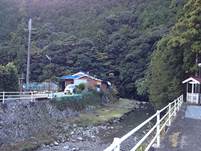
The village I found appeared to have changed only minimally in the past 80 years since my grandmother had left it. Old houses dotted a rocky landscape with no stores or businesses to speak of, with the only noise that shattered the idyllic silence the sound of the occasional passing car on the nearby highway. I wasn't able to find any trace of my family aside from a few graves in the town graveyard (that appeared to house more souls than the actual village) that carried my grandmother's maiden name on them, but even then, I couldn't confirm they were actually my ancestor's graves (my cousin later on alerted me that I had missed the ancestral site by a few yards).
Monday, November 19 - Field Trip to Nara
 Unlike the previous trip, the trip to the ancient capital of Nara would be a day trip only, so we wouldn't need to bring our belongings for an overnight stay. In the morning, we left on a charter bus headed to the Horyuji (法隆寺) Temple Complex in Nara, which, like Shitennouji in Osaka, was commissioned by Prince Shotoku, and built around 607. The central pagoda is believed to be one of the oldest extant wooden buildings in the world, and the temple complex contains many treasures considered to be the finest examples of 7th-8th century Buddhist art in the world.
Unlike the previous trip, the trip to the ancient capital of Nara would be a day trip only, so we wouldn't need to bring our belongings for an overnight stay. In the morning, we left on a charter bus headed to the Horyuji (法隆寺) Temple Complex in Nara, which, like Shitennouji in Osaka, was commissioned by Prince Shotoku, and built around 607. The central pagoda is believed to be one of the oldest extant wooden buildings in the world, and the temple complex contains many treasures considered to be the finest examples of 7th-8th century Buddhist art in the world.
 After leaving Horyu-ji, we stopped for lunch at a buffet-style restaurant that featured many local delicacies, some of which were unknown to many of the other students. Being from Los Angeles with access to many Japanese foodstuffs, most of it I had tried at one time or another previously, but it was nevertheless incredibly delicious.
After leaving Horyu-ji, we stopped for lunch at a buffet-style restaurant that featured many local delicacies, some of which were unknown to many of the other students. Being from Los Angeles with access to many Japanese foodstuffs, most of it I had tried at one time or another previously, but it was nevertheless incredibly delicious.
From there, we took the bus to the Todaiji (東大寺) temple in Nara, which houses the largest bronze Buddha statue in the world, known as the Daibutsu (大仏), which was built in 743. In addition to the temple buildings, one of the most notable features of Todaiji is the number of deer that run wild around the temple complex and beg for food from the visitors.
Tuesday, November 20 - Lecture/Completion Ceremony
In the morning, we had a brief lecture where we discussed what we had seen in Nara and discussed things we learned during the program in general, what our favorite Japanese words were, and what we had come to discover about Japan. Following the lecture, we had an information session on procedures for returning home, since not all the students were returning to their various countries at the same time.
Since this was the last day of the program, we had a graduation ceremony where we were presented with certificates stating that we had completed the program. Many of the host families had returned to watch their students graduate, and many of the students wore their national costume to the event. Afterwards, we had a closing ceremony party and were given the textbooks we had ordered previously.
The very last activity was held that afternoon, when a group of middle school students came to visit the foreigners (us!), play cultural exchange games, and perform some songs for us.

That night, us students held a karaoke party on the 3rd floor of the Institute so we could laugh and sing and say goodbye to the good friends we had made over the course of the trip.
Wednesday, November 21 - Return Home
After trying to cram in some last-minute shopping (I had bought so many things to bring home that I had to buy an extra small suitcase), I finally said goodbye to the Kansai Institute and boarded my plane for the US. Though it was only two weeks, we had all learned and experienced so much about Japan, and I can't wait to go back.